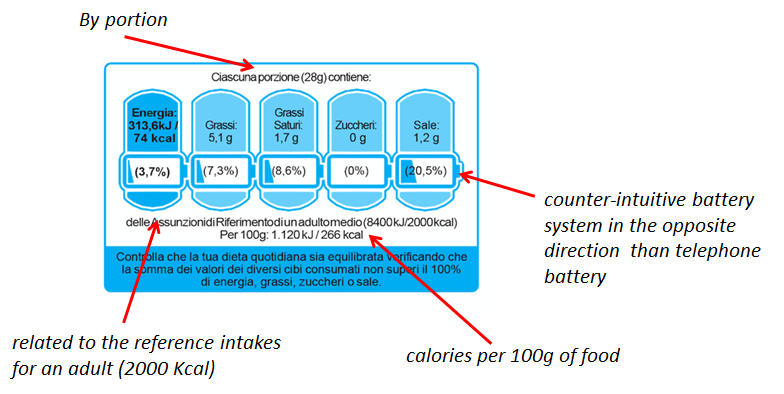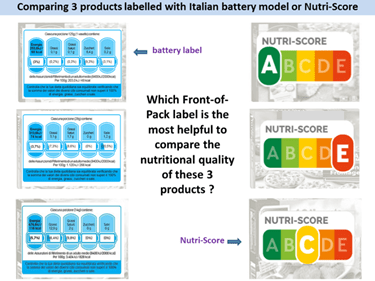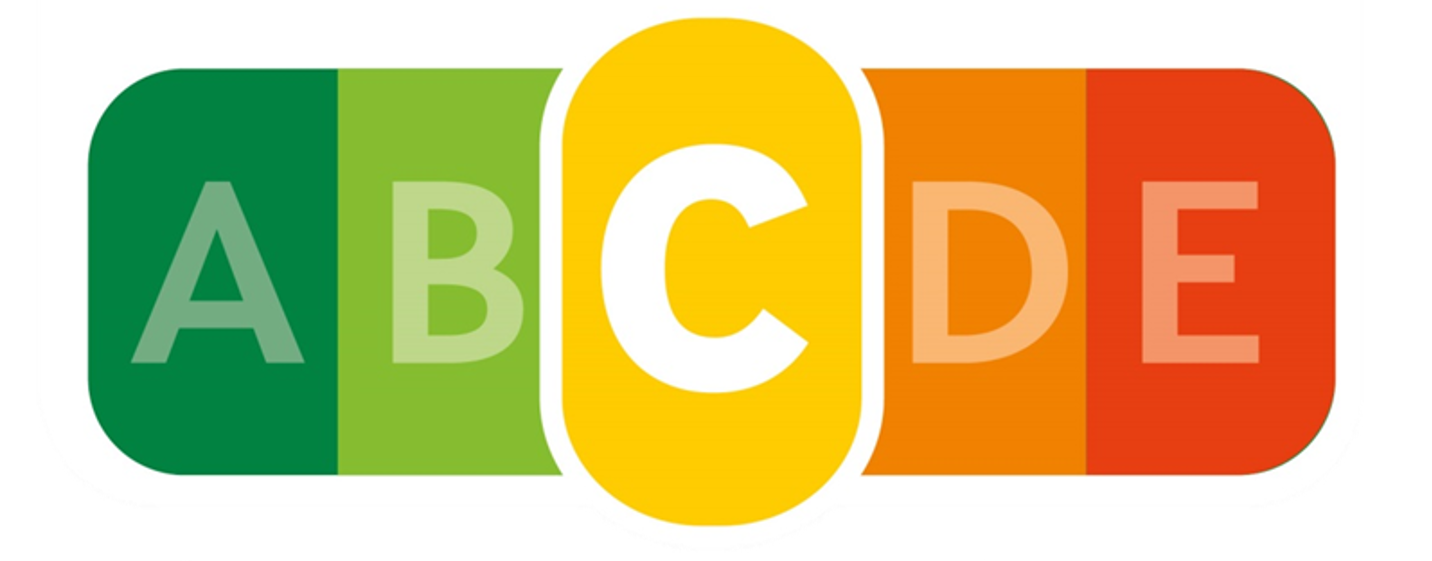The Italian Nutrinform nutritional front-of-pack label is born out of a process of rejection of the Nutri-Score linked in fact, not to discussions of public health strategies, but to purely internal political and economic issues in Italy.
Alongside the arguments (irrelevant and unfounded) against Nutri-Score and widely taken up by the Italian agro-food lobbies and under their pressure, 4 Italian ministries have proposed their alternative to Nutri-Score, the Nutrinform battery system. This system provides, in a single diagram, the quantity of energy, saturated fats, sugars and salt for a portion of food and the percentage that these represent in relation to the average reference intakes for an adult (the theoretical percentage of reference intakes is also presented in the drawing of a battery/battery on the model of those used for charging mobile phones). There are two graphical forms of presentation that can be found in the documents presented by the Italian government and the Italian agro-food lobbies (FedereAlimentare, Coldiretti):

One can see that the principle of this logo, which provides in a monochrome way, information by nutrients, is from its principle and graphic representation very close to the GDA/RI set up by the companies in the 2000s:

The Italian Government decree notified at EC level, refers to this lineage, stating that the Reference Intakes have been used as a scientific basis, by envisaging a kind of evolution of the current IR icons (e.g. GDA) through the development of a graphical form that is « easier for the consumer to grasp and which thus enables him to understand immediately the extent to which the portion of the food he will consume contributes to his energy and nutrient requirements, to which particular attention should be paid (fat, saturated fat, sugars and salt) ».
However, a great deal of scientific work has demonstrated total ineffectiveness of GDA/RIs. All independent studies show that GDA/RI is difficult for consumers to understand and interpret, and do not allow for food products comparisons. It does not show a favorable impact on consumer purchasing behavior. Italian batteries are very similar to GDA/RI which, on the basis of its complexity, has been rejected by consumer associations and public health structures for many years, asking for a colorful, gradual and synthetic logo.
Another major flaw of the Italian batteries is its reference to the portion and not to the standard reference to 100g of food (or 100 ml for liquids). The latter is a recommendation of the WHO and public health structures because it allows an objective comparison of food products on the same basis and avoids the use of portion sizes that are not standardized and often defined by the manufacturers themselves (varying from one brand to another): for example, for cheese pizzas the recommended portion size varies from brand to brand, some offering a 100g portion, others 123g, others 150g, others 175g… It is therefore impossible to make the calculation based on portion sizes. This was also the basis of the ENL logo proposed by 6 large multinational companies and abandoned in 2018. It was inspired by the British Traffic Lights but instead of displaying the score for 100 grams of food, ENL score was calculated on the basis of a « portion », i.e. the quantity usually consumed by a person, a highly variable notion… Since it is the manufacturers who define the size of the portion, the measuring instrument changes according to the manufacturer’s proposal. A study has shown that, unlike the Nutri-Score (which refers to 100g of food) the use of the ENL (calculated per portion) had a very limited effect in reducing the portion size of low quality products and even tends to increase the portion size for spreads by falsely reassuring consumers. https://www.ncbi.nlm.nih.gov/pmc/articles/PMC6165438/
The battery system is all the more complex and difficult to understand as the quantities of nutrients refer to a portion, the percentages are related to the reference intakes for an adult (2000 Kcal) and the caloric intake per 100g of food is added …
Finally, the Italian system seems particularly counter-intuitive, representing the nutrient content through the icon traditionally used to monitor the charge of a telephone or electrical appliance, but curiously used in the Italian logo in the opposite direction (the more the battery is « discharged », the better the nutritional quality of the food!). This misleading use of the battery diagram has been highlighted by consumer associations, particularly in Italy (Altro-Consumo) and at European level by BEUC, which have rejected the system.

Numerous studies conducted, with the sole purpose of understanding objectively, in more than 12 countries (including 6 European countries) comparing 5 nutrition logos (including Nutri-Score and GDA/RI) have shown that the Nutri-Score is the most effective logo to help consumers compare the nutritional quality of foods (https://www.mdpi.com/2072-6643/10/9/1268?utm_source=TrendMD&utm_medium=cpc&utm_campaign=Nutrients_TrendMD_0 ). This study was also recently carried out among 1023 Italian consumers. The results observed are identical to the other countries and the GDA/RI was the least effective logo (in all the countries tested), having no difference in impact with the situation without the logo. (https://www.mdpi.com/2072-6643/12/8/2307).
All in all, the battery system does not have a serious scientific background (unlike the Nutri-Score). The two studies cited in the Italian decree are weak from a methodological viewpoint and one of the recently published studies was carried out by a university team of Business and Management and financed by the anti-Nutri-Score lobby (Federalimentare, the Italian Federation of Food Industry).
The Italian system is totally rejected by consumer associations who consider it difficult to understand and misleading; and on the other hand, it is supported by food lobbies who consider it as a bulwark against Nutri-Score (for example https://www.luinonotizie.it/2020/08/16/varese-no-al-nutriscore-si-alletichetta-a-batteria-che-protegge-la-qualita-dei-nostri-prodotti/295951) and a means of preserving the image of products « made in Italy ».
The Italian government notified its draft decree to the EC for the use of the battery system in Italy and obtained an agreement in August 2020. It leaves the possibility for designation of origin products not to use the logo (PDO, PGI and TSG certified products). Some European agricultural lobbies such as AIPROM-Crop Protection Association have given their support to the NutrInform battery system but, on the other hand, no industrial company has officially committed itself, even in Italy, to adopting it (unlike Nutri-Score, which has been adopted by several hundred food companies (large and small), and retailers in Europe).
*******
To illustrate the difficulty of understanding the Italian battery system compared to Nutri-Score, here’s an example to compare 3 products:

________
Serge Hercberg (1), Nancy Babio (2,3), Pilar Galán (1), Jordi Salas-Salvadó (2,3)
1. Sorbonne Paris Cité Epidemiology and Statistics Research Center (CRESS), U1153 Inserm, U1125, Inra, Cnam, Paris 13 University, Nutritional Epidemiology Research Team (EREN), Bobigny, 93000, France, 2. Universitat Rovira i Virgili. Departament de Bioquímica i Biotecnologia. Unitat de Nutrición Humana. Hospital universitari Sant Joan de Reus. Institut d’Investigació Pere Virgili (IISPV), Reus, España Joan de Reus, Institut d’Investigació Pere Virgili (IISPV), Reus, España. 3 Consorcio CIBER, M.P. Fisiopatología de la Obesidad y Nutrición (CIBEROBN), Instituto de Salud Carlos III (ISCIII), Madrid, España.
______
